Means of electrochemical protection of metals
 МMethods and means of metal protection against corrosion could be divided into four separate categories:
МMethods and means of metal protection against corrosion could be divided into four separate categories:
1.Protection through the changes in the environment.
2. Electrochemical protection.
3.Protective coating.
4.Alloying.
Let us examine one of these methods, particularly, electrochemical protection.
Electrochemical protection of metals against corrosion is performed using a special protector.
For example, the sea water is the place where galvanic steam is released from the metal that needs to be protected as well as from the protector of another more electro-negative metal which is directly contacting the product. In such an environment protector metal (anode (-)) collapses, thus, protecting the metal product (cathode (+)) from corrosion. Such kind of protection is often used for the constructions that are in the constant contact with water. During this process, zinc (Zn) and alloys of Аl + Мg, Аl+Zn, Сd+Zn, Аl are used with other metals.
Zinc is the most widely used metal for the protectors of the iron and duralumin alloys. In the sea water, the ratio of the protector’s surface (-) and construction’s surface must be kept within the range of 1/200 to 1/1,000, while the distance between the protector plates must be 2-3 meters.
The means of electrochemical protection against corrosion are used not only in the sea environment, but also in the places of underground pipeline location. In order to create a positive charge of a product, it is necessary to connect it to the negative pole of the continuous current generator. Thus, the product becomes a cathode and stops corroding.
The metal protection methods are used considering the character of corrosion and conditions of its development. Therefore, it is important to consider efficiency and expediency of this method of protection in such situation.




